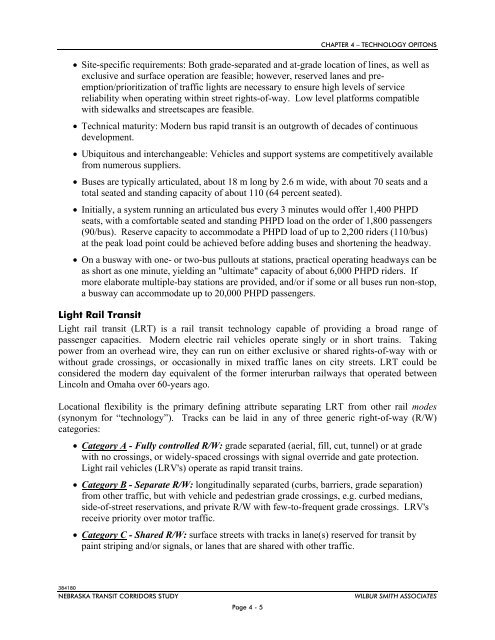NTRAC Final Study - Nebraska Department of Roads - State of ...
NTRAC Final Study - Nebraska Department of Roads - State of ...
NTRAC Final Study - Nebraska Department of Roads - State of ...
Create successful ePaper yourself
Turn your PDF publications into a flip-book with our unique Google optimized e-Paper software.
CHAPTER 4 – TECHNOLOGY OPITONS<br />
Site-specific requirements: Both grade-separated and at-grade location <strong>of</strong> lines, as well as<br />
exclusive and surface operation are feasible; however, reserved lanes and preemption/prioritization<br />
<strong>of</strong> traffic lights are necessary to ensure high levels <strong>of</strong> service<br />
reliability when operating within street rights-<strong>of</strong>-way. Low level platforms compatible<br />
with sidewalks and streetscapes are feasible.<br />
Technical maturity: Modern bus rapid transit is an outgrowth <strong>of</strong> decades <strong>of</strong> continuous<br />
development.<br />
Ubiquitous and interchangeable: Vehicles and support systems are competitively available<br />
from numerous suppliers.<br />
Buses are typically articulated, about 18 m long by 2.6 m wide, with about 70 seats and a<br />
total seated and standing capacity <strong>of</strong> about 110 (64 percent seated).<br />
Initially, a system running an articulated bus every 3 minutes would <strong>of</strong>fer 1,400 PHPD<br />
seats, with a comfortable seated and standing PHPD load on the order <strong>of</strong> 1,800 passengers<br />
(90/bus). Reserve capacity to accommodate a PHPD load <strong>of</strong> up to 2,200 riders (110/bus)<br />
at the peak load point could be achieved before adding buses and shortening the headway.<br />
On a busway with one- or two-bus pullouts at stations, practical operating headways can be<br />
as short as one minute, yielding an "ultimate" capacity <strong>of</strong> about 6,000 PHPD riders. If<br />
more elaborate multiple-bay stations are provided, and/or if some or all buses run non-stop,<br />
a busway can accommodate up to 20,000 PHPD passengers.<br />
Light Rail Transit<br />
Light rail transit (LRT) is a rail transit technology capable <strong>of</strong> providing a broad range <strong>of</strong><br />
passenger capacities. Modern electric rail vehicles operate singly or in short trains. Taking<br />
power from an overhead wire, they can run on either exclusive or shared rights-<strong>of</strong>-way with or<br />
without grade crossings, or occasionally in mixed traffic lanes on city streets. LRT could be<br />
considered the modern day equivalent <strong>of</strong> the former interurban railways that operated between<br />
Lincoln and Omaha over 60-years ago.<br />
Locational flexibility is the primary defining attribute separating LRT from other rail modes<br />
(synonym for “technology”). Tracks can be laid in any <strong>of</strong> three generic right-<strong>of</strong>-way (R/W)<br />
categories:<br />
Category A - Fully controlled R/W: grade separated (aerial, fill, cut, tunnel) or at grade<br />
with no crossings, or widely-spaced crossings with signal override and gate protection.<br />
Light rail vehicles (LRV's) operate as rapid transit trains.<br />
Category B - Separate R/W: longitudinally separated (curbs, barriers, grade separation)<br />
from other traffic, but with vehicle and pedestrian grade crossings, e.g. curbed medians,<br />
side-<strong>of</strong>-street reservations, and private R/W with few-to-frequent grade crossings. LRV's<br />
receive priority over motor traffic.<br />
Category C - Shared R/W: surface streets with tracks in lane(s) reserved for transit by<br />
paint striping and/or signals, or lanes that are shared with other traffic.<br />
384180<br />
NEBRASKA TRANSIT CORRIDORS STUDY<br />
Page 4 - 5<br />
WILBUR SMITH ASSOCIATES

















